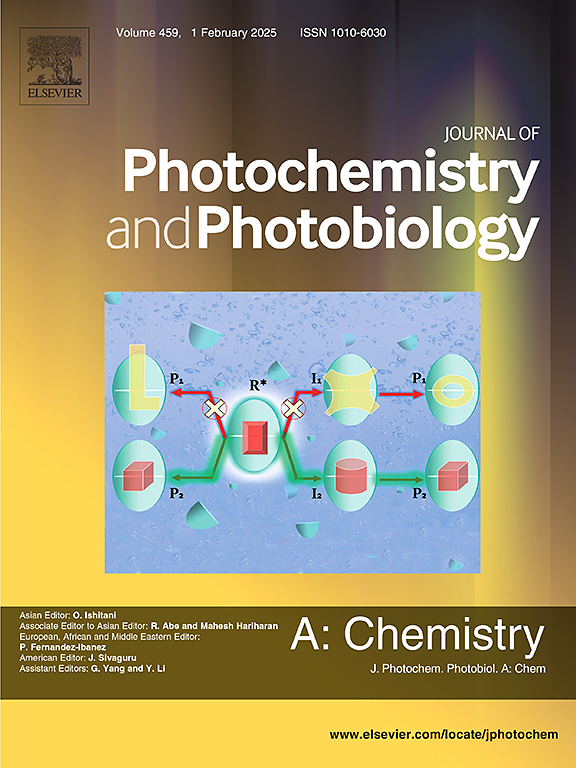Stability, electronic, optical and vibrational spectra of copper octa-fluorophthalocyanine (F8CuPc) and its conformations : A DFT/TDDFT study
IF 4.1
3区 化学
Q2 CHEMISTRY, PHYSICAL
Journal of Photochemistry and Photobiology A-chemistry
Pub Date : 2025-03-26
DOI:10.1016/j.jphotochem.2025.116397
引用次数: 0
Abstract
We report on the energetics of formation, geometric optimization, ionization energies, Ultraviolet–visible (UV–Vis) spectroscopy, vibrational frequency analysis, and electronic properties of pristine Copper octa-fluorophthalocyanine (F8CuPc) and its four different conformations as obtained using the ground-state density-functional theory (DFT) and time-dependent density-functional theory (TDDFT) approaches. The conformations have been constructed by permutation and substitution between fluorine and hydrogen atoms of the F8CuPc. Based on the calculated formation energy, we found that one of the conformations, termed ’A’, is the most stable, and is even more stable than the widely known pristine F8CuPc. Our vibrational analysis show an absence of imaginary frequencies thus suggesting the stability of F8CuPc and its four conformations. The structural parameters obtained for the conformations are consistent with the available experimental and theoretical data. Across the conformations, the band gap, E varies. Of particular interest is the = 0.80 eV obtained for the most stable conformation A. Such a value of band gap makes this conformation of F8CuPc suitable for absorbing sunlight in the near-infrared region thereby making it useful for harvesting energy from this part of the solar spectrum. More interestingly is the fact that the electronic and optical properties of this important molecule, i.e Fe8CuPc can be tuned by permutations of the constituents atoms of fluorine and hydrogen. This opens the possibility of functionalization of surfaces or nanostructures with the conformations, for specific applications.

求助全文
约1分钟内获得全文
求助全文
来源期刊
CiteScore
7.90
自引率
7.00%
发文量
580
审稿时长
48 days
期刊介绍:
JPPA publishes the results of fundamental studies on all aspects of chemical phenomena induced by interactions between light and molecules/matter of all kinds.
All systems capable of being described at the molecular or integrated multimolecular level are appropriate for the journal. This includes all molecular chemical species as well as biomolecular, supramolecular, polymer and other macromolecular systems, as well as solid state photochemistry. In addition, the journal publishes studies of semiconductor and other photoactive organic and inorganic materials, photocatalysis (organic, inorganic, supramolecular and superconductor).
The scope includes condensed and gas phase photochemistry, as well as synchrotron radiation chemistry. A broad range of processes and techniques in photochemistry are covered such as light induced energy, electron and proton transfer; nonlinear photochemical behavior; mechanistic investigation of photochemical reactions and identification of the products of photochemical reactions; quantum yield determinations and measurements of rate constants for primary and secondary photochemical processes; steady-state and time-resolved emission, ultrafast spectroscopic methods, single molecule spectroscopy, time resolved X-ray diffraction, luminescence microscopy, and scattering spectroscopy applied to photochemistry. Papers in emerging and applied areas such as luminescent sensors, electroluminescence, solar energy conversion, atmospheric photochemistry, environmental remediation, and related photocatalytic chemistry are also welcome.

 求助内容:
求助内容: 应助结果提醒方式:
应助结果提醒方式:


